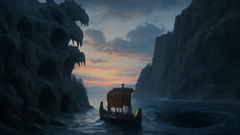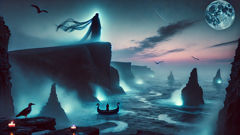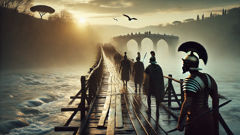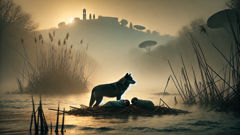Introduction
Along the narrow throat of the Strait of Messina, where the Ionian Sea spills into the Tyrrhenian and the land leans close as if to listen, two dangers kept a steady vigil. One lived in fissured cliffs and brine-soaked caves, six heads tasting the air and eyes like smoldering coals; the other was a hungry hollowness in the water, a roiling throat that swallowed waves and spit them back as ruin. Sailors who passed those waters learned to read the sea as if it were scripture—studying eddies, listening for the change of gulls, trusting not only charts and stars but the small, private superstitions that a lifetime of voyages can build. The names Scylla and Charybdis are spoken like a warning and a prayer, compressed into a single phrase that travelers still use when they must choose between two evils. This tale wanders beyond the shorthand. It traces the geology that made the Strait a knife, the storytellers who shaped faces into monsters, and the human stories—of courage, calculation, and stubborn hope—that have kept the myth alive. In the hush before dawn, with sea-wind in the rigging and the cliffs asleep in a violet hush, imagine a small ship cutting the water, its crew narrow-eyed and intent. They are not merely navigating a passage; they are negotiating memory, a layered map of rock and sea and spoken fear inherited across generations. This story seeks the textures under the names: salt-stiff ropes, the metallic taste of fear, the way light fractures on shallow shoals, and how an ancient people turned wild and dangerous geography into a story that could teach, terrify, and endure.
Origins, Geography, and the Making of Monsters
The geography of the Strait of Messina is honest about danger. It squeezes water through a narrow channel, the tides tugging east and west with an insistent force that turns calm into chaos in a matter of hours. From the shore, the rocks look indifferent; up close, they are cunning. Underwater shelves and sudden drop-offs catch currents and throw them into whirlpools. A seam opens and closes with lunar patience, and the sea, obedient to the pull of the moon and the shape of the seabed, convulses where a ship expects steady flow. To a people who made their living by the sea, these patterns were a language. Before written records, the first mariners shaped names and faces from what they could not control. A whirlpool was not a phenomenon to be analyzed; it was a throat, swallowing the world. A cliff that gouged at passing ships became an animal, a guardian, or a predator. Scylla and Charybdis were born from that need to make sense of casualty and randomness.
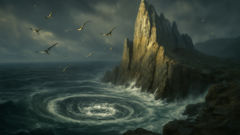
The classical accounts handed down by poets and chroniclers populated the landscape with personalities. Scylla is often imagined perched like a stalled hunger on a dizzying rock-face: a creature of fossil and salt, part-woman in some tellings, part-savage beast in others, her heads snapping at oars and sails. Charybdis, by contrast, is the sea’s own maw—an abyss that sucks in water and blood and then throws it back in a foaming tantrum. But what the ancients could sense in the canyon between Sicily and mainland Italy made such descriptions persuasive. They had eyewitness testimony in the grooves of their harbor stones, in the skeletons washed ashore, and in the precise timbre of warnings passed from captain to captain. The first storytellers did not manufacture monsters out of nothing; they traced the edge between cause and consequence with the blunt instrument of metaphor.
Archaeology and modern marine science have since explained much of the Strait’s behavior. Tidal currents collide, countercurrents curl, and wind patterns buffet the passage at irregular angles. The channel's narrowing multiplies flow velocity, creating eddies, standing waves, and whirlpools near submerged promontories. In certain conditions a surface vortex can form with enough power to drag small craft into a sudden, spinning descent. Along the northern shore, shelves of limestone drop away abruptly; waves smashing into those shelves can create vertical turbulence and dangerous ledges. Such details make the myth feel less supernatural but also more intimate: the truth is not less wild because it is natural. It is, in fact, an invitation to respect the sea’s architecture.
The stories also carry social memory. Communities that skirt that narrow throat grew rules—avoid daylight when a certain wind sets in, keep a respectful distance from particular rocks, sacrifice little tokens to favor luck. Elder sailors learned to read the whales and the birds, the pattern of foam, the slight bruise of color in the water that hinted at an undercurrent. Over time, these pragmatic rules were embroidered with narrative: a tavern tale about a ship swirled away by a sudden maelstrom; a mothers' whisper to a boy leaving for his first voyage. Mythic names, then, were both mnemonic anchors and moral compasses. By personifying danger as Scylla and Charybdis, storytellers made it imaginable and discussable. A commander could say, "We will hug the shore and risk Scylla," and every man would understand the trade he was asked to accept.
Language altered the landscape further. The phrase "between Scylla and Charybdis" became shorthand for a dilemma that forced a choice between two evils—an echo that persists in modern speech. But the phrase also compresses a richer seam of human experience: the way people cope with environments that are indifferent to desire or need. When a mariner chooses to circumnavigate a rock and face the teeth of Scylla, or to ride farther out and risk the mouth of Charybdis, he is not simply picking a route. He is engaging with contingency, weighing loss against loss, and accepting uncertain outcomes. That psychological fact is why the story traveled beyond local harbors; it addresses a human condition.
In the ancient mind, myth and ritual braided together. Temples and shrines near harbors held votive offerings shaped like miniature ships; sailors left small models or inscribed slabs asking for favor. The sea demanded attention and a kind of moral accounting. A ship that ignored warning signs and pressed on was not only risking lives but breaking a compact: it was flouting the unwritten rules that maintained collective safety. Thus Scylla and Charybdis are part monster and part ethical actor. They test prudence and reveal hubris. They are cautionary figures for a people who could not control weather or tide but could instruct one another in the art of surviving them.
Over centuries, artists and poets layered more detail onto these two figures. Pottery and frescoes gave Scylla a furious animus—her multiple heads bent toward the water like hungry buds—and Charybdis a more abstract, architectural horror: a churning cavern where the sea folded inward. Roman commentators and later medieval scribes mixed the original Greek threads with regional folktales; fresh metaphors were grafted on and, when translated across languages, some subtleties shifted. But the central structure stayed intact: a narrow passage, two dangers in opposition, and the human need to name and live with peril. Geology and myth thus coexisted, each enriching the other. The Strait offered a template for imagination, and imagination returned the favor by turning the passage into a place of stories people could carry in their pockets as they sailed away.
Even today, modern sailors draw on the old caution and the new science. Charts carry notes about eddies; weather services issue warnings; local pilots accompany larger vessels. But the old names persist, and when a storm blows up and gulls fall silent, there is a habit of speech that reaches back: "Mind the Scylla," someone might mutter, half in jest and half in gratitude to the past that taught them to watch the water. The monsters, then, are both relic and living map—symbols that began as explanation and matured into a language of respect for the sea's inscrutable choreography.
Encounters, Symbolism, and the Legacy of Two Dangers
Stories of sailors meeting Scylla and Charybdis are narrated in tones that range from pragmatic to elegiac. Some tellings focus on the mechanics: how a captain, sensing the telltale bruises of cross-currents, ordered his crew to cut their sails and row, keeping the bow into the swell while they hugged a particular bank of calmer water. Others foreground the terror—a sudden scream as an oar vanishes into froth, the terrible slowness of watching a comrade dragged down. These variations reflect different aims: the first is survival advice handed down like a map; the second is a performance of grief, a way communities contained tragedy. In both registers, however, the human figure is rooted: the sailor who must make fast decisions under pressure, who feels the ocean's logic press against his ribs, who learns that the smallest choices—where to turn the helm, which rope to lash—can decide between going home and never returning.

The Odyssey gives perhaps the oldest widely known literary framing that evokes both perils in sequence: a hero forced to choose the lesser of two calamities. But the mythic resonance of Scylla and Charybdis did not end with classical antiquity. Renaissance painters, baroque poets, and modern novelists have borrowed the tension to dramatize moments of decision. Artists use the image of twin threats to explore political dilemmas, moral paradoxes, and the human cost of choice. On a civic level, the phrase evolved into a metaphor in counsel and rhetoric: leaders invoked the twin dangers when guiding citizens through crises, arguing that prudence required navigating between different forms of harm. The metaphor has an ethical bite: to chose is to accept consequences, sometimes grievous, and the line between necessity and culpability is rarely neat.
Symbolically, Scylla and Charybdis embody complementary fears. Scylla is the visible predator—immediate, tangible, and close enough for envy or contempt. Charybdis is the invisible maw—remote, impersonal, and therefore harder to rally against. In psychological terms, the pair captures the dual nature of risk: the danger you can see and the danger you can't. This duality surfaces across cultures because it offers a compact grammar for discussing risk management. A small ship's captain must weigh the immediate cost of sacrificing a few to save many or the long-term cost of risking everything to avoid a local loss. That calculation is universal and explains why the metaphor has migrated into varied contexts: literature, business, diplomacy.
Yet the legacy of the monsters also has a humanizing thread. Folktales recorded in coastal communities often emphasize cleverness, negotiation, and cunning rather than brute force. A mariner might throw offerings into a churning pool not because he truly believed they would placate a deity but because ritual calmed hands and focused minds. In other tales a local pilot, presumably more experienced, wards off disaster simply by steering in a line that trades a ragged jib for a secure hull. These narratives preserve a subtle ethic: knowledge, local custom, and communal wisdom are as powerful as courage. Practiced navigation becomes a kind of social memory, a repository of accumulated adaptations to an unforgiving world.
Modern science both demystifies and deepens our appreciation of the Strait. Sonar maps, tidal models, and satellite imagery reveal the precise choreography under the waves that produces eddies and vortices. Yet those revelations often have an almost mythic quality: when a scientist explains the dynamics that lead to a whirlpool, the mechanism is elegant and strange enough to inspire awe similar to that of ancient storytellers. The new language—a vocabulary of vorticity, shear, and turbulence—does not cancel the old stories; it translates them. The human impulse to narrate survives the explanation. We still tell stories about the sea because stories shape memory and emotion in ways equations cannot.
The cultural legacy of Scylla and Charybdis is also tangible in material culture. Coastal museums preserve fishermen’s tools and votive miniatures; local festivals commemorate the sea with songs that mention the old names in passing. Tourism has added another layer. Tour operators bring visitors to look out over the Strait, and guides weave the most evocative tales for maximum effect. In shops near the harbors, magnets and postcards show fanciful, sometimes grotesque depictions of the monsters—images that are part souvenir and part extension of the myth into the present economy. This commercialization has a double edge: while it risks flattening nuance into spectacle, it also keeps the story in circulation, ongoing and living.
Finally, the story survives because it answers a psychological need: humans require frames for rare, catastrophic events. Scylla and Charybdis are narrative tools that help us cope with randomness. They convert chance into story, and story into meaning. A sailor who loses a brother to the sea might find consolation in the thought that he was taken by a named force, a participatory actor in a larger tale. Yet the story also asks hard questions. In casting danger as an external monster, does myth sometimes let us evade responsibility? Do we, in modern times, risk similar abdication when we attribute systemic social harms to faceless forces? The twin monsters thus provoke reflection not only about navigation but about how we narrate peril.
Encounters with Scylla and Charybdis, whether literal or metaphorical, have therefore never been only about survival. They are about memory, language, and ethics. They teach a practical lesson—mind the currents—but they also teach a cultural one: to name danger is to make it part of the community's conversation, to subject it to human judgment, ritual, and art. The monsters of the Strait are as much a product of human imagination as they are of waves and stone; the two together produced a story that endures because it helps people live with what they cannot fully command. In that way, the narrow channel between shores becomes a classroom where geology meets myth, and both insist we pay attention.
When you stand on the cliffs today and watch ferries stitch across the water, you can still feel the old tension. Engines hum where oars once strained, but the currents keep their tricks. Local pilots still know which little strip of calmer water will carry a vessel safely past a jagged shelf, and the phrase "between Scylla and Charybdis" still clicks in conversation like a compass reading. That living phrase ties us to the mariners who first learned the Strait's grammar by bitter practice, and it reminds us that every passage across an uncertain place is a small act of storytelling—an attempt to make chaos legible and to carry home what matters most.
Conclusion
The tale of Scylla and Charybdis endures because it binds natural fact to human interpretation. It began when people named danger in order to share survival techniques: where to row, when to reef sails, and which stones to avoid. It matured into metaphor, offering a compact image for dilemmas that require choosing between two harms. Across centuries it has served as a map, an ethical parable, and a cultural emblem—traced in pottery, sung at harbors, and whispered in pilots' cabins. The Strait of Messina still tests those who pass, but the modern world layers explanations over awe: tidal models, nautical charts, and engine-driven ferries now share the stage with votive offerings and telling tales. Perhaps the most important legacy is that of human response. The story remembers technical ingenuity and communal prudence as much as it remembers tragedy. Naming shaped practice, and practice shaped naming; the monsters became teachers. Standing on the cliffs as storms gather, one hears again the old counsel—mind the rocks, watch the eddies, listen to the birds—and understands how story and skill have always gone together. In that sense Scylla and Charybdis are not merely relics of a mythic past but living reminders of how communities learn to live with danger: by watching, by sharing what they know, and by telling the stories that help the next generation find its way through the narrow places.

